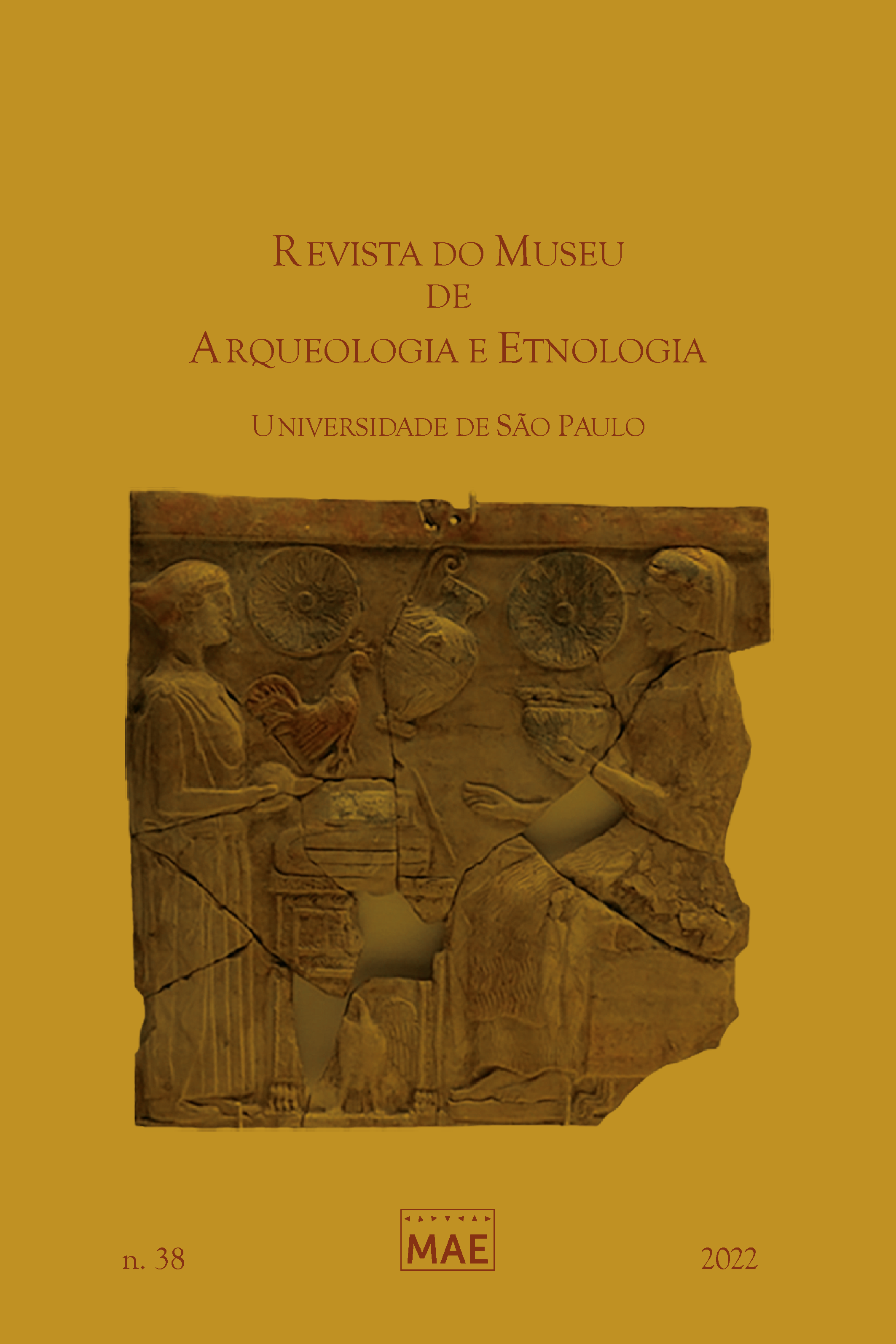Osirian circuit in TT49: iconography, epigraphy and symbolism in a transition tomb
DOI:
https://doi.org/10.11606/issn.2448-1750.revmae.2022.189215Keywords:
Theban tombs, Post-Amarna, Osiris, Ritual circulation, SpacesAbstract
The Osirian figure and world, neutralized by Akhenaten, have as counterpart a reaction embodied in the post-Amarnian integral reaction. This response involves both the iconographic repertoire embodied in the representations and in the epigraphic registers of the tombs. In this way, and beyond the strictly Osirian figure, the conception of the Hereafter regains a place previously annulled during the Amarnian interregnum. The tomb of Neferhotep (TT49), dated in the reign of Pharaoh Ay (c.a. 1323-1320) is therefore a transitional tomb that offers extraordinary stylistic characteristics. What is proposed here is a detailed analysis of the presence of the god Osiris in the two-dimensional representations as well as in the epigraphic record in the context of the tomb. Then, emphasizing in the chapel in particular, an interpretation of the symbolism linking the south west pillar with the south wall of the statues niche and the stele on the west wall, south side, will be presented.
Downloads
References
Arnold, D. 1999. Old kingdom statues in their architectural setting. In: Metropolitan Museum of Art. Egyptian art in the age of the pyramids. Metropolitan Museum of Art, New York, 41-49.
Assmann, J. 1991. Das Grab des Amenemope TT 41. P. von Zabern, Mainz am Rheim, 2 vols.
Bonanno, M. 2021. An Osiris new solar epithet in TT 49? Considerations about the nocturnal sun in the chapel. In: Franci, M.; Ikram, S.; Morfini, I. (Eds.). Rethinking Osiris: proceedings of the International Conference, Florence, Italy, 26-27 March 2019. Arbor Sapientiae, Rome, 19-28.
Bonanno, M.; Pereyra, M.V. 2019. El registro de Osiris en TT49: continuidades y cambios. In: Brancaglion Junior, A.; Gama-Rolland, C.; Chapot, G. (Org.). Semna: Estudos de Egiptologia VI. 2a. ed. Seshat, Rio de Janeiro, 80-99.
Bourdieu, P. 1971. Genése et structure du champ religioux. Revue Francaise de Sociologie 12: 295-334.
Breining, L. 2012. Astronomy, cosmology, and religious expression in the New Kingdom: a study of late ramesside cosmological funerary scenes. Master’s Thesis. University of Memphis, Memphis.
Davies, N. de G. 1933. The tomb of Neferhotep at Thebes. Metropolitan Museum of Art, New York.
Gamelin, T. 2017. Appliquer le mythe grâce au rite… ou l’inverse? L’image égyptienne face à celle de ses voisines. Nouvelle Mythologie Comparée 3: 79-119.
Hartwig, M. 2004. Tomb painting and identity in ancient Egypt, 1419-1372. Brespols, Brussels.
Hornung, E. 1997. Der ägyptische Mythos von der Himmelskuh: eine Ätiologie des Unvollkommenen. 3. ed. Universitätsverlag Freiburg Schweiz, Fribourg.
Kemp, J.B. 1992. El antiguo Egipto: anatomía de una civilización. Crítica, Barcelona.
Kiser-Go, D. 2006. A stylistic and iconographic analysis of private post-amarna period tombs in Thebes. Ph.D. Thesis. University of California, Berkeley.
McCarthy, H.L. 2002. The Osiris Nefertari: a case study of decorum, gender and regeneration. Journal of the American Research Center in Egypt 39: 173-195
Pereyra, M.V. et al. 2006. Imágenes a preservar en la tumba de Neferhotep (TT 49). Universidad Nacional de Tucumán, Tucumán.
Pereyra, M.V. 2009. Redes sociales e iconografía. Trabajos de Egiptología 5: 151-161.
Pereyra, M.V. 2011. El gran templo de Amón en la tumba de Neferhotep (TT49). Revista del Instituto de Historia Antigua Oriental 17: 17-26.
Pereyra, M. V.; Manzi, L.; Broitman, L. 2013. La tumba tebana 49 y su propietario en el paisaje sacralizado del occidente tebano, Egipto. Arqueología 19: 103-123.
Pereyra, M. V. et al. 2019. Neferhotep y su espacio funerario: ritual y programa decorativo. Instituto Multidisciplinario de Historia y Ciencias Humanas.
RankeH. 1935. The origin of the Egyptian tomb statue. Harvard Theological Review 28: 45-53.
Roth, A. 1999. The absent spouse: patterns and taboos in Egyptian tomb decoration. Journal of the American Research Center in Egypt 36: 37-53.
Smith, M. 2017. Following Osiris. Oxford University Press, Oxford.
Thausing, G. 1943. Der Auferstehunsgedanke in ägyptischen religiösen Texten. Otto Harrassowitz, Leipzig.
van Walsem, R. 2005. Iconography of Old Kingdom elite tombs: analysis & interpretation: theoretical and methodological approaches. Peeters, Leuven.
Downloads
Published
Issue
Section
License
Copyright (c) 2022 Mariano Bonanno

This work is licensed under a Creative Commons Attribution-NonCommercial-NoDerivatives 4.0 International License.













